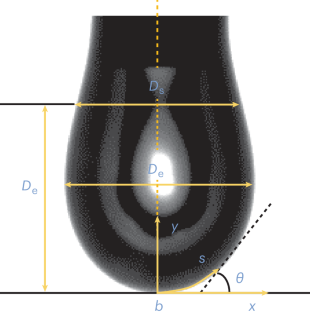通过动态垂滴表征确定界面特性
IF 13.1
1区 生物学
Q1 BIOCHEMICAL RESEARCH METHODS
引用次数: 0
摘要
材料之间的界面特性对各个领域都有实际影响,包括毛细作用、泡沫和乳液稳定性、材料的粘附特性以及传质和传热过程。研究界面动力学也是了解分子间相互作用、分子构象变化和分子聚集的基础。悬滴张力测量法及其扩展方法--振荡滴法--是用于测量表面张力、界面张力和界面流变特性的简单而通用的方法。然而,由于材料制备不充分、校准方法不正确、分析数据选择不当、忽略光学影响或在线性粘弹机制之外操作系统,这些方法可能会产生不可靠的结果。此外,许多研究未能报告准确的不确定性。本规程解决了所有这些关键点,并详细介绍了一些操作技巧,涉及不同种类材料的净化方法、分析测量数据的时间框架、光学效应的校正方法、使用普通可编程泵实施振荡法,以及测量过程中遇到的一些常见问题的补救措施。我们还提供了两相和三相系统的界面张力测量实例,以及 N2 和表面活性剂溶液的界面扩张模量测量实例,以说明程序细节和结果。完成一次测量需要几分钟到几小时,而包括泄漏测试、清洁、重复测量和数据分析在内的整个规程可能需要几天时间。本文章由计算机程序翻译,如有差异,请以英文原文为准。


Interfacial property determination from dynamic pendant-drop characterizations
The properties of the interface between materials have practical implications in various fields, encompassing capillary action, foam and emulsion stability, adhesion properties of materials and mass and heat transfer processes. Studying the dynamics of interfaces is also fundamental for understanding intermolecular interactions, change of molecular conformations and molecular aggregations. Pendant-drop tensiometry and its extension, the oscillating drop method, are simple, versatile methods used to measure surface tension, interfacial tension and interfacial rheological properties. These methods can, however, generate unreliable results because of inadequate material preparation, an incorrect calibration method, inappropriate selection of data for analysis, neglect of optical influences or operating the system outside the linear viscoelastic regime. In addition, many studies fail to report accurate uncertainties. This protocol addresses all these critical points and provides detailed descriptions of some operation tips relating to purifying methods for different kinds of material, the time frame for analyzing measurement data, the correction method for optical effects, implementation of the oscillating method with a common programmable pump and remedies for some common problems encountered during the measurement. Examples of interfacial tension measurements for two- and three-phase systems, as well as interfacial dilational modulus measurements for N2 and surfactant solutions, are provided to illustrate procedural details and results. A single measurement takes minutes to hours to complete, while the entire protocol, including the leak test, cleaning, repeated measurements and data analysis, may take several days. Surface tension, interfacial tension and interfacial rheological properties can be calculated from droplet images. This article presents a standardized protocol for pendant-drop tensiometry and the oscillating drop method in two- and three-phase systems.
求助全文
通过发布文献求助,成功后即可免费获取论文全文。
去求助
来源期刊

Nature Protocols
生物-生化研究方法
CiteScore
29.10
自引率
0.70%
发文量
128
审稿时长
4 months
期刊介绍:
Nature Protocols focuses on publishing protocols used to address significant biological and biomedical science research questions, including methods grounded in physics and chemistry with practical applications to biological problems. The journal caters to a primary audience of research scientists and, as such, exclusively publishes protocols with research applications. Protocols primarily aimed at influencing patient management and treatment decisions are not featured.
The specific techniques covered encompass a wide range, including but not limited to: Biochemistry, Cell biology, Cell culture, Chemical modification, Computational biology, Developmental biology, Epigenomics, Genetic analysis, Genetic modification, Genomics, Imaging, Immunology, Isolation, purification, and separation, Lipidomics, Metabolomics, Microbiology, Model organisms, Nanotechnology, Neuroscience, Nucleic-acid-based molecular biology, Pharmacology, Plant biology, Protein analysis, Proteomics, Spectroscopy, Structural biology, Synthetic chemistry, Tissue culture, Toxicology, and Virology.
 求助内容:
求助内容: 应助结果提醒方式:
应助结果提醒方式:


